Book contents
- Frontmatter
- Before the Shakespeare Revolution: Developments in the Study of Nineteenth-Century Shakespearian Production
- The Meininger Company and English Shakespeare
- Shakespeare at the Burgtheater: From Heinrich Anschütz to Josef Kainz
- Shakespeare on the Melbourne Stage, 1843-61
- Shakespeare in Hazlitt’s Theatre Criticism
- Characterization of the Four Young Lovers in A Midsummer Night’s Dream
- Queenly Shadows: On Mediation in Two Comedies
- Language, Theme, and Character in Twelfth Night
- The Art of the Comic Duologue in Three Plays by Shakespeare
- ‘Spanish’ Othello: The Making of Shakespeare’s Moor
- Ferdinand and Miranda at Chess
- Shakespeare’s Latin Citations: The Editorial Problem
- The Theatre at Christ Church, Oxford, in 1605
- Interpretations of Shakespearian Comedy, 1981
- The Year's Contributions to Shakespearian Study 1 Critical Studies
- 2 Shakespeare’s Life, Times and Stage
- 3 Textual Studies
- Index
- Plate Section
Ferdinand and Miranda at Chess
Published online by Cambridge University Press: 28 March 2007
- Frontmatter
- Before the Shakespeare Revolution: Developments in the Study of Nineteenth-Century Shakespearian Production
- The Meininger Company and English Shakespeare
- Shakespeare at the Burgtheater: From Heinrich Anschütz to Josef Kainz
- Shakespeare on the Melbourne Stage, 1843-61
- Shakespeare in Hazlitt’s Theatre Criticism
- Characterization of the Four Young Lovers in A Midsummer Night’s Dream
- Queenly Shadows: On Mediation in Two Comedies
- Language, Theme, and Character in Twelfth Night
- The Art of the Comic Duologue in Three Plays by Shakespeare
- ‘Spanish’ Othello: The Making of Shakespeare’s Moor
- Ferdinand and Miranda at Chess
- Shakespeare’s Latin Citations: The Editorial Problem
- The Theatre at Christ Church, Oxford, in 1605
- Interpretations of Shakespearian Comedy, 1981
- The Year's Contributions to Shakespearian Study 1 Critical Studies
- 2 Shakespeare’s Life, Times and Stage
- 3 Textual Studies
- Index
- Plate Section
Summary
Here Prospero discoversFerdinand andMiranda playing at chess.
Miranda
Sweet lord, you play me false.
Ferdinand.
No, my dearest love, I would not for the world.
Miranda
Yes, for a score of kingdoms you should wrangle, And I would call it fair play.
Alonso
If this prove A vision of the island, one dear son Shall I twice lose.
Allusions to chess are rare in Shakespeare. The term chess itself is used only once, in the stage direction from the final act of The Tempest given above. The plot moves steadily towards this crowning 'vision of the island', when Prospero draws back the curtain of the inner stage to reveal to his former enemy a tableau consisting of their 'lost' children. Why, at such a crucial moment, did Shakespeare choose to have these young lovers discovered absorbed in chess?
Some commentators have attempted to answer this question by relating the episode to contemporary chess history. Philip Brockbank felt it important that the greatest player of the age, Giacchino Greco (il Calabrese), 'was much about that time visiting England from Italy'. However, Greco (1600-34) w a s only eleven when the play was first performed. The upsurge of interest in chess resulting from his celebrated visit (1622-4) could hardly have influenced Shakespeare's conception of The Tempest - though Middleton may well have derived inspiration for his A Game at Chesse (1624) whilst watching the master playing in London. Furness was more accurate in his contention that during Shakespeare's lifetime Naples had become an acclaimed centre of chess activity so that 'there was a special and remarkable appropriateness in representing a Prince of Naples as a Chessplayer'.
- Type
- Chapter
- Information
- Shakespeare Survey , pp. 113 - 118Publisher: Cambridge University PressPrint publication year: 1982
- 2
- Cited by



